Требуется руководство для вашей Hotpoint-Ariston LTB 6B019 C EU Посудомоечная машина? Ниже вы можете просмотреть и загрузить бесплатно руководство в формате PDF. Кроме того, приведены часто задаваемые вопросы, рейтинг изделия и отзывы пользователей, что позволит оптимально использовать ваше изделие. Если это не то руководство, которое вы искали, – свяжитесь с нами.
Ваше устройство неисправно, и в руководстве отсутствует решение? Перейдите в Repair Café для получения бесплатных ремонтных услуг.
Руководство

Рейтинг
Сообщите нам, что вы думаете о Hotpoint-Ariston LTB 6B019 C EU Посудомоечная машина, оставив оценку продукта. Хотите поделиться вашими впечатлениями от данного изделия или задать вопрос? Вы можете оставить комментарий в нижней части страницы.
Довольны ли вы данным изделием Hotpoint-Ariston?
Да Нет
4 голоса
Часто задаваемые вопросы
Наша служба поддержки выполняет поиск полезной информации по изделиям и отвечает на часто задаваемые вопросы. Если вы заметили неточность в наших часто задаваемых вопросах, сообщите нам об этом с помощью нашей контактной формы.
После завершения цикла посудомоечной машины отсек с моющим средством не открылся. Почему? Проверенный
Данная проблема часто возникает, когда посуда блокирует отсек. Прежде, чем запускать машину, убедитесь, что отсек не заблокирован.
Это было полезно (7705)
Почему посудомоечная машина перестала нагревать воду? Проверенный
Скорее всего, нагревательный элемент неисправен. Его следует заменить. В случае сомнений обратитесь к производителю.
Это было полезно (7018)
Можно ли в посудомоечной машине использовать обычную соль? Проверенный
Нет, поваренная соль может содержать вещества, которые споcобны повредить ваше устройство.
Это было полезно (2998)
Нужно ли ополаскивать посуду, прежде чем поместить ее в посудомоечную машину? Проверенный
Ополаскивать посуду необязательно, однако следует удалить все крупные, твердые и жирные остатки пищи. Со временем они могут засорить слив.
Это было полезно (1195)
Могу ли я открыть посудомоечную машину во время ее работы? Проверенный
Большинство посудомоечных машин оснащены устройством остановки подачи воды, благодаря чему программа останавливается сразу же при открытии дверцы, что означает, что вода не будет вытекать. С некоторыми моделями со временем это может вызвать проблемы. При использовании встраиваемых посудомоечных машин частое открывание посудомоечной машины во время работы может привести к повреждению окружающих шкафов водой из-за выделяющегося пара.
Это было полезно (916)
Следует ли открывать посудомоечную машину после того, как она закончила работу, чтобы посуда высохла быстрее? Проверенный
Это зависит от типа посудомоечной машины и ее расположения. Некоторые посудомоечные машины оснащены функцией сушки посуды после программы мойки. В этом случае открытие посудомоечной машины не принесет никакой пользы. При использовании встраиваемых посудомоечных машин частое открывание посудомоечной машины во время работы может привести к повреждению окружающих шкафов водой из-за выделяющегося пара.
Это было полезно (732)
После того, как посудомоечная машина завершит свой цикл, пластиковая посуда еще влажная, а остальная — нет. Это почему? Проверенный
Пластик — плохой проводник тепла, позволяющий продуктам быстро остывать. Влага, которая остается на нем, испаряется гораздо меньше, чем, например, на керамике или металле.
Это было полезно (653)
Царапины на металле внутри посудомоечной машины — это проблема? Проверенный
Внутренняя часть большинства посудомоечных машин изготовлена из нержавеющей стали и не подвержена царапинам.
Это было полезно (589)
Можно ли мыть в посудомоечной машине деревянные предметы, например, шпатели и разделочные доски? Проверенный
Нет. Деревянные предметы можно повредить или покоробить в посудомоечной машине. Кроме того, высвобождающиеся древесные волокна могут повредить посудомоечную машину. Деревянные разделочные доски часто изготавливаются с использованием клея, который может отслоиться после нескольких раз мытья в посудомоечной машине.
Это было полезно (589)
Можно ли мыть посуду с тефлоном в посудомоечной машине? Проверенный
Да, ты можешь. Однако сковорода изнашивается быстрее, чем при ручной очистке. При чистке сковороды тефлоном вручную никогда не используйте мочалку, а используйте мягкую губку или ткань.
Это было полезно (588)
Можно ли подключить посудомоечную машину к удлинителю? Проверенный
Технику, требующую большого количества энергии, например посудомоечную машину, нельзя подключать ко всем удлинителям. Посмотрите, какова потребляемая мощность посудомоечной машины, которая указывается в ваттах, и проверьте, справится ли с этим удлинитель. Существуют удлинители с более толстыми кабелями, предназначенные для работы с более крупными приборами.
Это было полезно (588)
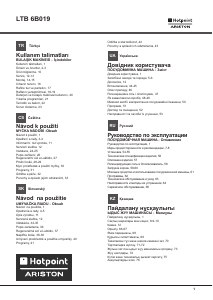

1
RU
Русский
Руководство по эксплуатации
ПОСУДОМОЕЧНАЯ МАШИНА — Оглавление
Руководство по эксплуатации, 1
Меры предосторожности и рекомендации, 7-8
Установка, 54-55
Техническая спецификация изделия, 56
Описание изделия, 57
Регенерирующая соль и Ополаскиватель, 58
Загрузка корзин, 59-60
Моющее средство и использование посудомоечной машины, 61
Программы, 62
Техническое обслуживание и уход, 63
Неисправности и методы их устранения, 64
Сервисное обслуживание, 65
TR
Türkçe
Kullanım talimatları
BULAŞIK MAKİNESİ — İçindekiler
Kullanım talimatları, 1
Önlem ve öneriler, 2-3
Ürün bilgilerine, 10
Servis, 12-13
Montaj, 14-15
Cihazın tanımı, 16
Rane tuz ve
parlatıcı
, 17
Raarın yerleştirilmesi, 18-19
Deterjan ve bulaşık makinesi kullanımı, 20
Yıkama
programları
, 21
Temizlik ve bakım, 22
Sorun Giderme, 23
KZ
Қазақша
Пайдалану нұсқаулығы
ЫДЫС ЖУУ МАШИНАСЫ — Мазмұны
Пайдалану нұсқаулығы, 1
Сақтық шаралары мен кеңес, 8-9-10
Көмек, 12
Орнату, 66-67
Өнім парақшасы, 68
Құрылғы сипаттамасы, 69
Тазаланған тұз және шаюға көмекші зат, 70
Тартпаларға жүктеу, 71-72
Жуғыш зат пен ыдыс жуу машинасын қолдану, 73
Жуу циклдары, 74
Күтім және техникалық қызмет көрсету, 75
Ақаулықтарды жою, 76
UA
Українська
Довідник користувача
ПОСУДОМИЙНА МАШИНА — Зміст
Довідник користувача, 1
Запобіжні заходи та поради, 5-6
Допомога, 12
Встановлення, 44-45
Опис приладу, 46
Регенераційна сіль і ополіскувач, 47
Як завантажити короби, 48-49
Миючий засіб і використання посудомийної машини, 50
Програми, 51
Догляд та очищення
, 52
Несправності та засоби їх усунення, 53
CS
Čeština
Návod k použití
MYČKA NÁDOBÍ -Obsah
Návod k použití, 1
Opatření a rady, 3-4
Informační list výrobku, 11
Servisní služba, 12
Instalace, 24-25
Popis zařízení, 26
Regenerační sůl a Leštidlo, 27
Plnění košů, 28-29
Mycí prostředek a použití myčky, 30
Programy, 31
Údržba a péče, 32
Poruchy a způsob jejich odstranění, 33
SK
Slovenský
Návod na použitie
UMÝVAČKA RIADU — Obsah
Návod na použitie, 1
Opatrenia a rady, 4-5
Opis výrobku, 11
Servisná služba, 12
Inštalácia, 34-35
Popis zariadenia, 36
Regeneračná soľ a Leštidlo, 37
Naplňte koše
, 38-39
Umývací prostriedok a použitie umývačky, 40
Programy, 41
Údržba a starostlivosť, 42
Poruchy a spôsob ich odstránenia, 43
Displayed below is the user manual for LTB 6B019 C EU by Hotpoint which is a product in the Dishwashers category.
This manual has pages.

1
EN
DAILY REFERENCE
GUIDE
THANK YOU FOR BUYING A HOTPOINT-ARISTON
PRODUCT. In order to receive a more complete
assistance, please register your appliance on:
www.hotpoint.eu/register
You can download the Safety Instructions and the Use
and Care Guide, by visiting our website
docs.hotpoint.eu and following the Instructions on the
back of this booklet.
Before using the appliance carefully read Health and Safety guide.
PRODUCT DESCRIPTION
APPLIANCE
1. Upper rack
2. Foldable flaps
3. Upper rack height adjuster
4. Upper spray arm
5. Lower rack
6. Cutlery basket
7. Lower spray arm
8. Filter Assembly
9. Salt reservoir
10.Detergent and Rinse Aid dispensers
11.Rating plate
12. Control panel
0000 000 00000
Service:
1
2
3
4
5
6
10
12
7
11
9
8
CONTROL PANEL
1. On-Off/Reset button with indicator light
2. Program selection button
3. Rinse Aid refill indicator light
4. Salt refill indicator light
5. Program indicator lights
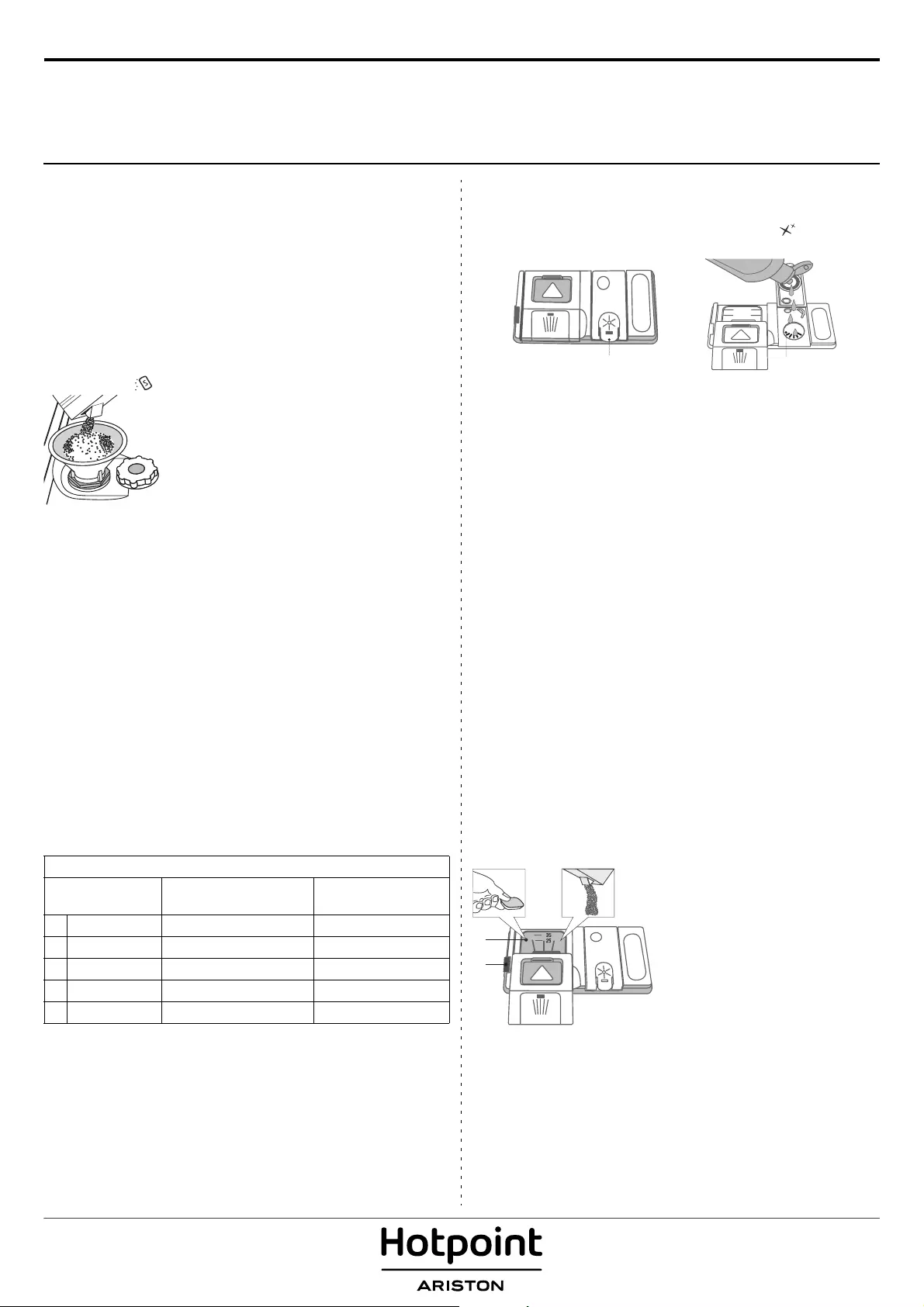
2
FIRST TIME USE
SALT, RINSE AID AND DETERGENT
ADVICE REGARDING THE FIRST TIME USE
After installation, remove the stoppers from the racks and the retaining
elastic elements from the upper rack.
FILLING THE SALT RESERVOIR
The use of salt prevents the formation of LIMESCALE on the dishes and
on the machine’s functional components.
• It is important that the salt reservoir be never empty
• It is important to set the water hardness.
The salt reservoir is located in the lower part of the dishwasher (see
PROGRAMS DESCRIPTION) and should be filled when the SALT REFILL
indicator light in the control panel is lit.
1.Remove the lower rack and unscrew the
reservoir cap (anticlockwise).
2.Only the first time you do this: fill the salt
reservoir with water.
3.Position the funnel
(see figure)
and fill the salt
reservoir right up to its edge (approximately 1 kg);
it is not unusual for a little water to leak out.
4. Remove the funnel and wipe any salt residue away from the opening.
Make sure the cap is screwed on tightly, so that no detergent can get
into the container during the wash program (this could damage the
water softener beyond repair).
Whenever you need to add salt, it is mandatory to complete the
procedure before the beginning of the washing cycle.
SETTING THE WATER HARDNESS
To allow the water softener to work in a perfect way, it is essential that
the water hardness setting is based on the actual water hardness in
your house. This information can be obtained from your local water
supplier.
The factory setting is for average (3) water hardness.
• Switch on the appliance by pressing the ON/OFF button.
• Switch off the appliance by pressing the ON/OFF button.
• Hold down button P for 5 seconds, until you hear a beep.
• Switch on the appliance by pressing the ON/OFF button.
• The program indicator light of the current set level flashes.
• Press button P to select the desired hardness level (see WATER
HARDNESS TABLE).
• Switch off the appliance by pressing the ON/OFF button.
Setting is complete!
As soon as this procedure is complete, run a program without loading.
Only use salt that has been specifically designed for dishwashers.
After the salt has been poured into the machine, the SALT REFILL
indicator light switches off.
If the salt container is not filled, the water softener and the heating
element may be damaged as a result.
FILLING THE RINSE AID DISPENSER
Rinse aid makes dish DRYING easier. The rinse aid dispenser A should
be filled when the RINSE AID REFILL indicator light in the control
panel is lit.
1. Open the dispenser
B
by pressing and pulling up the tab on the lid.
2. Carefully introduce the rinse aid as far as the maximum (110 ml)
reference notch of the filling space — avoid spilling it. If this happens,
clean the spill immediately with a dry cloth.
3. Press the lid down until you hear a click to close it.
NEVER pour the rinse aid directly into the tub.
ADJUSTING THE DOSAGE OF RINSE AID
If you are not completely satisfied with the drying results, you can ad-
just the quantity of rinse aid used.
• Switch the dishwasher on using the ON/OFF button.
• Switch it off using the ON/OFF button.
• Press button P three times — a beep will be heard.
• Switch it on using the ON/OFF button.
•
The program indicator light of the current set level flashes.
• Press button P to select the level of rinse aid quantity to be
supplied.
• Switch it off using the ON/OFF button
Setting is complete!
If the rinse aid level is set to ZERO (ECO), no rinse aid will be supplied.
The LOW RINSE AID indicator light will not be lit if you run out of rinse aid.
A maximum of 4 levels can be set according to the dishwasher model.
The factory setting is specific to the model, please follow instruction
above to check this for your machine.
• If you see bluish streaks on the dishes, set a low number (1-2).
• If there are drops of water or limescale marks on the dishes, set a
high number (3-4).
FILLING THE DETERGENT DISPENSER
To open the detergent dispenser
use the opening device A. Introduce
the detergent into the dry dispenser
B only. Place the amount of
detergent for pre-washing directly
inside the tub.
1.When measuring out the detergent
refer to the mentioned earlier infor-
mation to add the proper quantity.
Inside the dispenser
B
there are indi—
cations to help the detergent dosing.
2. Remove detergent residues from the edges of the dispenser and
close the cover until it clicks.
3. Close the lid of the detergent dispenser by pulling it up until the
closing device is secured in place.
The detergent dispenser automatically opens up at the right time
according to the program.
Water Hardness Table
Level °dH
German degrees
°fH
French degrees
1 Soft 0 — 6 0 — 10
2 Medium 7 — 11 11 — 20
3 Average 12 — 17 21 — 30
4 Hard 17 — 34 31 — 60
5 Very hard 35 — 50 61 — 90
A
B
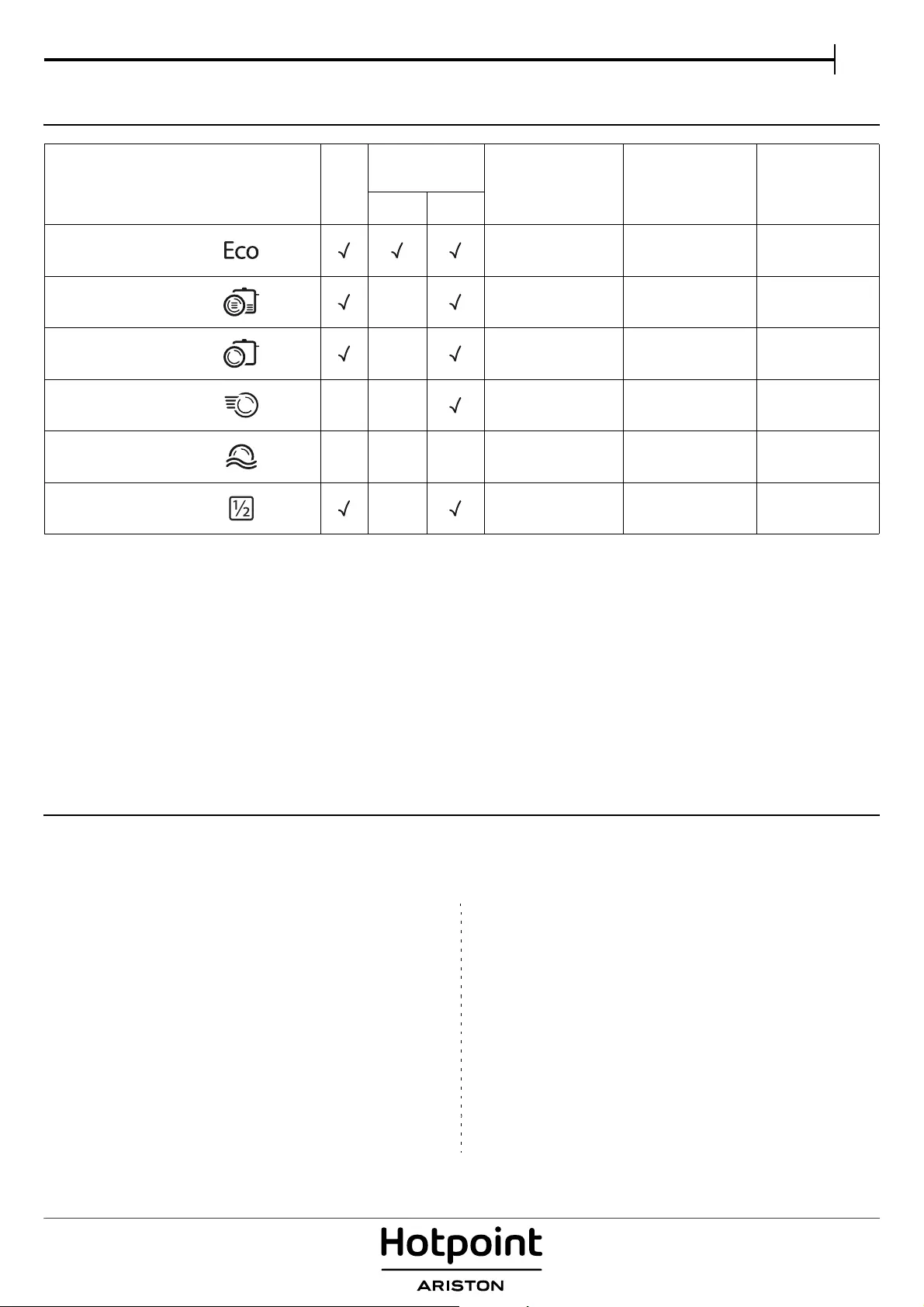
3
EN
PROGRAMS TABLE
ECO program data is measured under laboratory conditions according to European Standard EN 50242.
Note for Test Laboratories: For information on comparative EN testing conditions, please send an email to the following address:
assistenza_en_lvs@indesitcompany.com
Pre-treatment of the dishes is not needed before any of the programs.
*) The duration of the program shown on the display or in the booklet is an estimate calculated on standard conditions. The actual time may vary
depending on many factors such as temperature and pressure of the incoming water, room temperature, amount of detergent, quantity and type of load,
load balancing, additional selected options and sensor calibration. The sensor calibration can increase program duration up to 20 min.
Standby consumption: Left-on mode consumption: 5 W — Off mode consumption: 0.5 W
Program
Drying
phase
Detergent
container Duration
of wash program
(h:min)*)
Water
consumption
(litres/cycle)
Energy
consumption
(kWh/cycle)
Tub B
1. Eco 50° 3:20 12.0 1.04
2. Intensive 65° — 2:30 15.0 1.50
3. Normal 55° — 2:00 15.0 1.35
4. Express 40’ 50° — — 0:40 9.0 0.90
5. Soak — — — — 0:10 4.5 0.01
6. Half Load 50° — 1:20 12.0 1.10
PROGRAMS DESCRIPTION
Instructions on wash cycle selection.
ECO
Normally soiled crockery. Standard program, the most efficient in terms
of its combined energy and water consumption.
INTENSIVE
Program recommended for heavily soiled crockery, especially suitable
for pans and saucepans (not to be used for delicate items).
NORMAL
Normally soiled crockery. Everyday cycle, that ensures optimal cleaning
performance in shorter time.
EXPRESS 40’
Program to be used for lightly-soiled dishes with no dried food
residues.
SOAK
Crockery to be washed later. No detergent to be used with this
program.
HALF LOAD
Ideal for washing a half load of lightly or normally soiled crockery.
Notes:
Please note that cycles like Express or Fast are most effective for lightly
soiled dishes.
To reduce consumption even further, only run the dishwasher
when it is full.
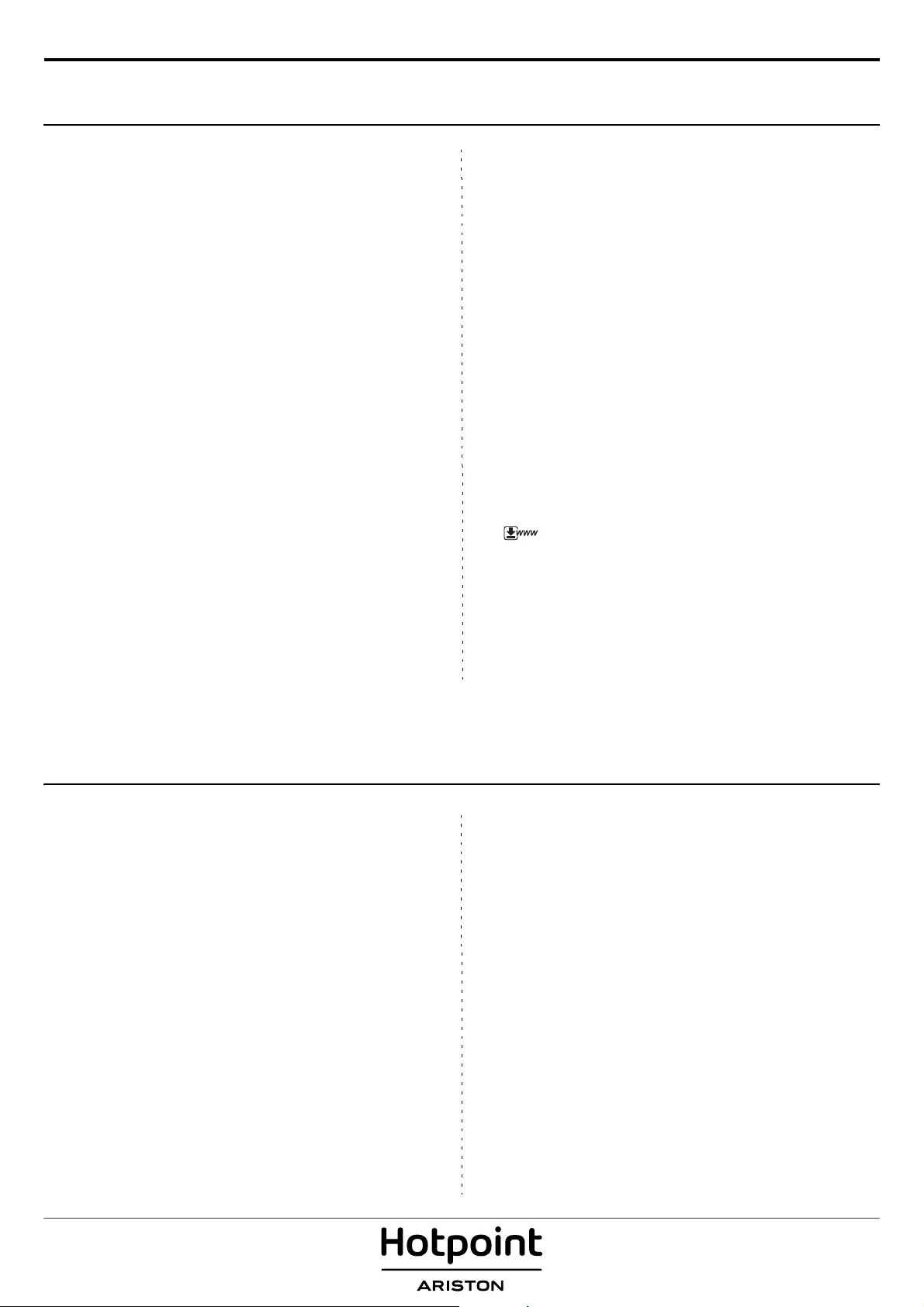
4
DAILY USE
1. CHECK WATER CONNECTION
Check that the dishwasher is connected to the water supply and
that the tap is open.
2. SWITCH ON THE DISHWASHER
Open the door and press the ON/OFF button.
3. LOAD THE RACKS
(see LOADING THE RACKS)
4. FILLING THE DETERGENT DISPENSER
(see PROGRAMS TABLE).
5. CHOOSE THE PROGRAM AND CUSTOMISE THE CYCLE
Select the most appropriate program in accordance with the type
of crockery and its soiling level (see PROGRAMS DESCRIPTION) by
pressing the P button.
6. START
Start the wash cycle by closing the door. When the program starts
you hear a beep.
7. END OF WASH CYCLE
The end of the wash cycle is indicated by beeps and by the flashing
of the indicator light of the selected program. Open the door and
switch off the appliance by pressing the ON/OFF button.
Wait for a few minutes before removing the crockery — to avoid
burns. Unload the racks, beginning with the lower one.
The machine will switch off automatically during certain extended
periods of inactivity, in order to minimise electricity consumption.
If the crockery is only lightly soiled or if it has been rinsed with
water before being placed in the dishwasher, reduce the amount
of detergent used accordingly.
MODIFYING A RUNNING PROGRAM
If a wrong program was selected, it is possible to change it, provided
that it has only just begun: open the door, press and hold the ON/OFF
button, the machine will switch off.
Switch the machine back on using the ON/OFF button and select the
new wash cycle and any desired options; start the cycle by closing the
door.
ADDING EXTRA CROCKERY
Without switching off the machine, open the door (be ware of HOT
steam!) and place the crockery inside the dishwasher. Close the door
and the cycle will begin from the point at which it was interrupted.
ACCIDENTAL INTERRUPTIONS
If the door is opened during the wash cycle, or if there is a power cut,
the cycle stops. It starts again from the point at which it was
interrupted once the door has been closed or the electricity supply is
restored.
For more information about the functions, you can request or download
from the WEB a Use & Care Guide by following the instructions on the last
page.
ADVICE AND TIPS
TIPS
Before loading the baskets, remove all food residues from the crockery
and empty the glasses. You do not need to rinse beforehand under
running water.
Arrange the crockery so that it is held in place firmly and does not tip
over; and arrange the containers with the openings facing downwards
and the concave/convex parts placed obliquely, thus allowing the
water to reach every surface and flow freely.
Warning: lids, handles, trays and frying pans do not prevent the
sprayer arms from rotating.
Place any small items in the cutlery basket.
Very soiled dishes and pans should be placed in the lower basket
because in this sector the water sprays are stronger and allow a higher
washing performance.
After loading the appliance, make sure that the sprayer arms can rotate
freely.
HYGIENE
To avoid odour and sediment which can be accumulated in the
dishwasher please run a high temperature program at least one a
month. Use a tea spoon of detergent and run it without the loading to
clean your appliance.
UNSUITABLE CROCKERY
• Wooden crockery and cutlery.
• Delicate decorated glasses, artistic handicraft and antique
crockery. Their decorations are not resistant.
• Parts in synthetic material which do not withstand high
temperatures.
• Copper and tin crockery.
• Crockery soiled with ash, wax, lubricating grease or ink.
The colours of glass decorations and aluminium/silver pieces can
change and fade during the washing process. Some types of glass (e.g.
crystal objects) can become opaque after a number of wash cycles too.
DAMAGE TO GLASS AND CROCKERY
• Only use glasses and porcelain guaranteed by the manufacturer as
dishwasher safe.
• Use a delicate detergent suitable for crockery
• Collect glasses and cutlery from the dishwasher as soon as the
wash cycle is over.
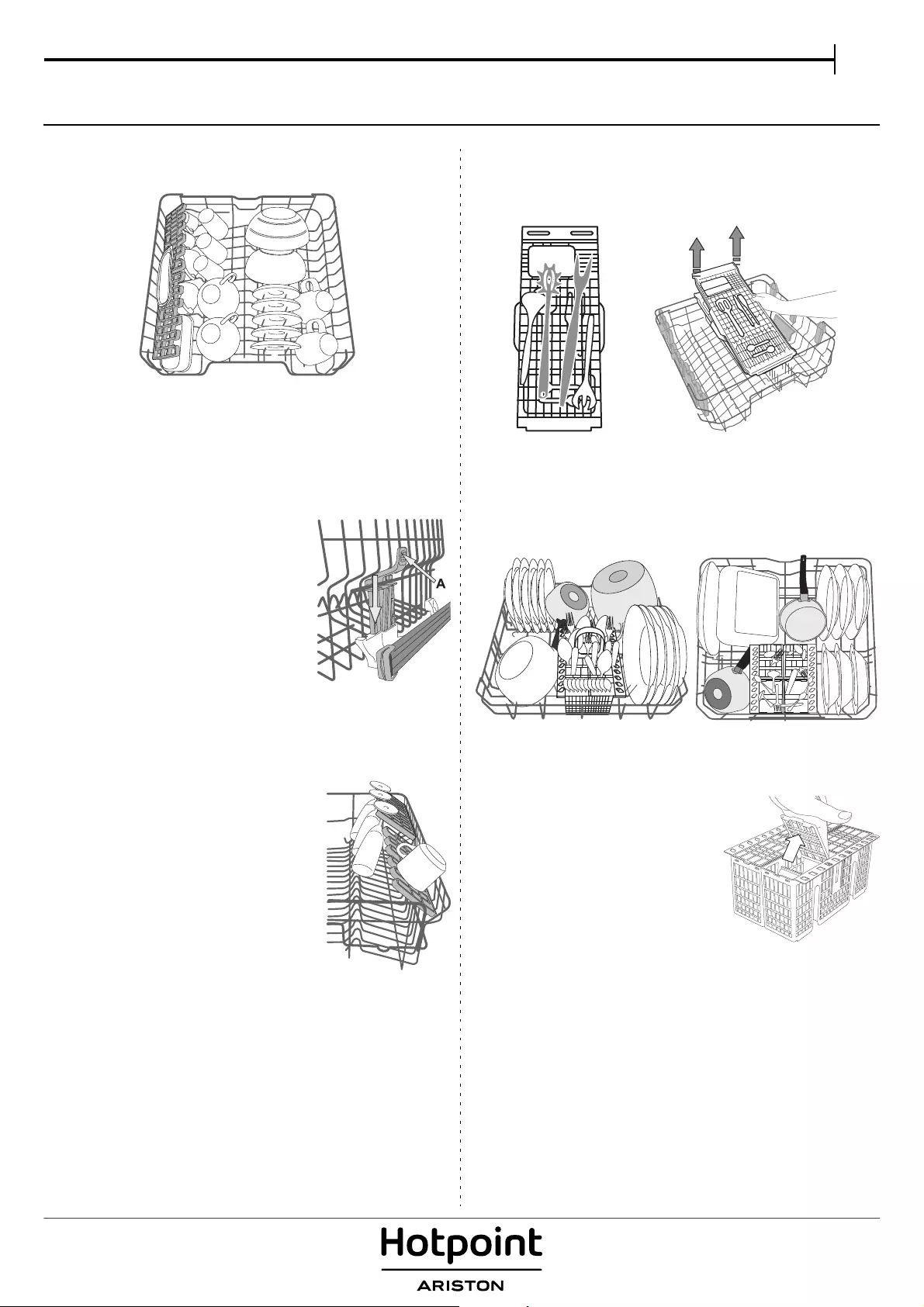
5
EN
LOADING THE RACKS
UPPER RACK
Load delicate and light dishes: glasses, cups, saucers, low salad bowls.
(loading example for the upper rack)
ADJUSTING THE HEIGHT OF THE UPPER RACK
The height of the upper rack can be adjusted: high position to place
bulky crockery in the lower basket and low position to make the most
of the tip-up supports by creating more space upwards and avoid
collision with the items loaded into lower rack.
The upper rack is equipped with a Upper
Rack height adjuster (see figure), without
pressing the levers, lift it up by simply
holding the rack sides, as soon as the rack is
stable in its upper position.
To restore to the lower position, press the
levers A at the sides of the rack and move
the basket downwards.
We strongly recommend that you do not
adjust the height of the rack when it is
loaded.
NEVER raise or lower the basket on one side only.
FOLDABLE FLAPS WITH ADJUSTABLE POSITION
The side foldable flaps can be positioned at
three different heights to optimize the
arrangement of crockery inside the rack.
Wine glasses can be placed safely in the
foldable flaps by inserting the stem of each
glass into the corresponding slots.
For optimum drying results incline the
foldable flaps more. To change the
inclination, pull up the foldable flap, slide it
slightly and position it as you wish.
SLIDING TRAY
The upper rack is fitted with a sliding tray which can be used to hold
small crockery and cutlery. For optimum washing performance, avoid
positioning bulky crockery directly below the tray. The tray is removable.
LOWER RACK
For pots, lids, plates, salad bowls, cutlery etc. Large plates and lids
should ideally be placed at the sides to avoid interferences with the
spray arm.
(loading example for the lower rack)
CUTLERY BASKET
The basket is equipped with top grilles
for improved cutlery arrangement. The
cutlery basket should be positioned only
at the front of the lower rack.
Knives and other utensils with sharp
edges must be placed in the cutlery
basket with the points facing
downwards or they must be
positioned horizontally in the tip-up
compartments on the upper rack.
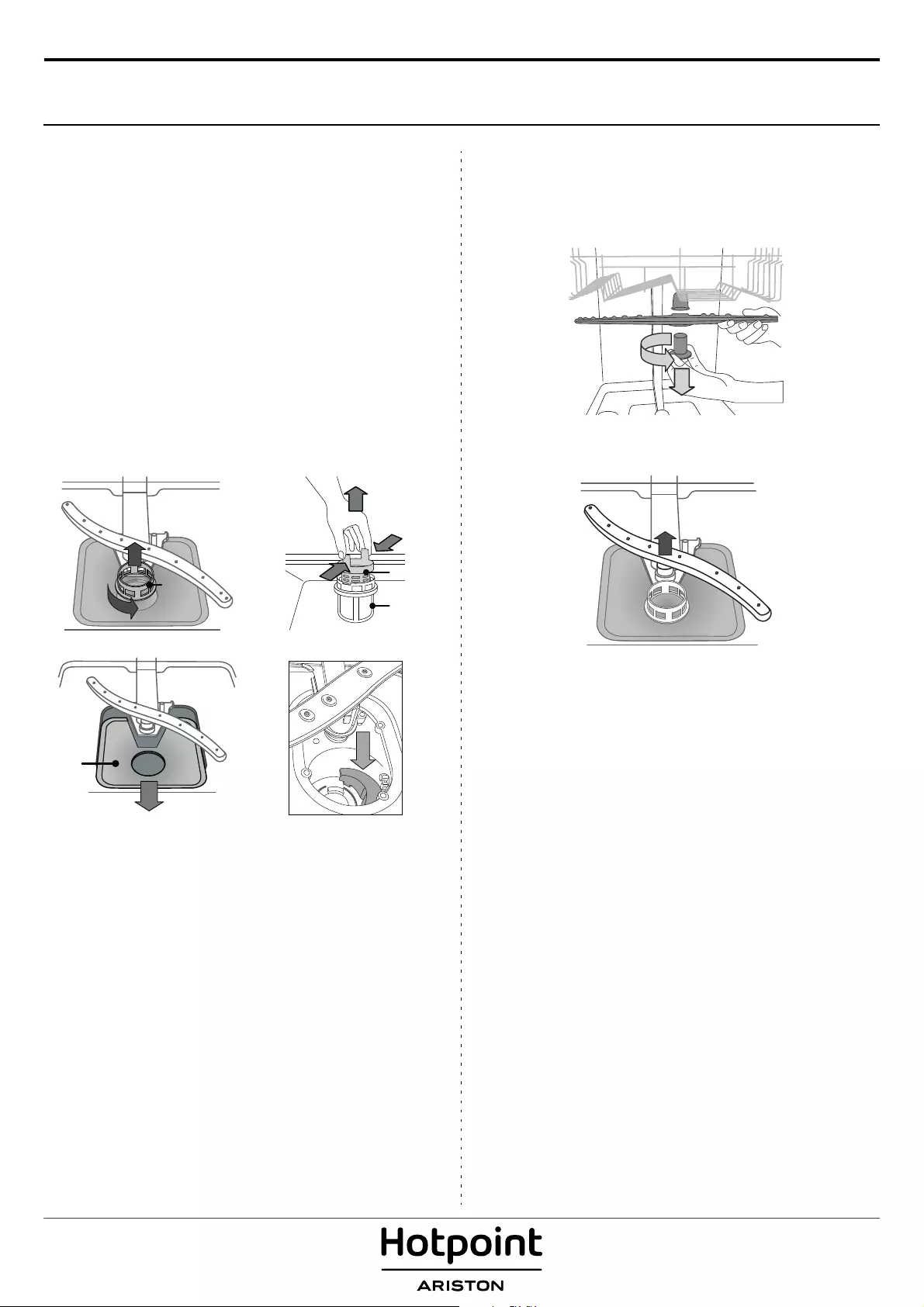
6
CARE AND MAINTENANCE
CLEANING THE FILTER ASSEMBLY
Regularly clean the filter assembly so that the filters do not clog and
that the waste water flows away correctly.
The filter assembly consists of three filters which remove food residues
from the washing water and then recirculate the water: to obtain the
best washing results, you need to keep them clean.
The dishwasher must not be used without filters or if the filter is
loose.
After several washes, check the filter assembly and if necessary clean it
thoroughly under running water, using a non-metallic brush and
following the instructions below:
1. Turn the cylindrical filter
A
in an anti-clockwise direction and pull it
out
(Fig 1)
.
2. Remove the cup filter
B
by exerting a slight pressure on the side
flaps
(Fig 2)
.
3. Slide out the stainless-steel plate filter
C
(Fig 3)
.
4. Inspect the trap and remove any food residues.
NEVER REMOVE
the
wash-cycle pump protection (black detail)
(Fig 4)
.
After cleaning the filters, re-place the filter assembly and fix it in
position correctly; this is essential for maintaining the efficient
operation of the dishwasher.
CLEANING THE SPRAY ARMS
On occasions, food residue may become encrusted onto the spray arms
and block the holes used to spray the water. It is therefore
recommended that you check the arms from time to time and clean
them with a small non-metallic brush.
To remove the upper spray arm, turn the plastic locking ring in an anti-
clockwise direction. The upper spray arm should be replaced so that
the side with the greater number of holes is facing upwards.
The lower spray arm may be removed by pulling it upwards.
CLEANING THE WATER INLET HOSE
If the water hoses are new or have not been used for an extended
period of time, let the water run to make sure it is clear and free of
impurities before performing the necessary connections. If this
precaution is not taken, the water inlet could become blocked and
damage the dishwasher.
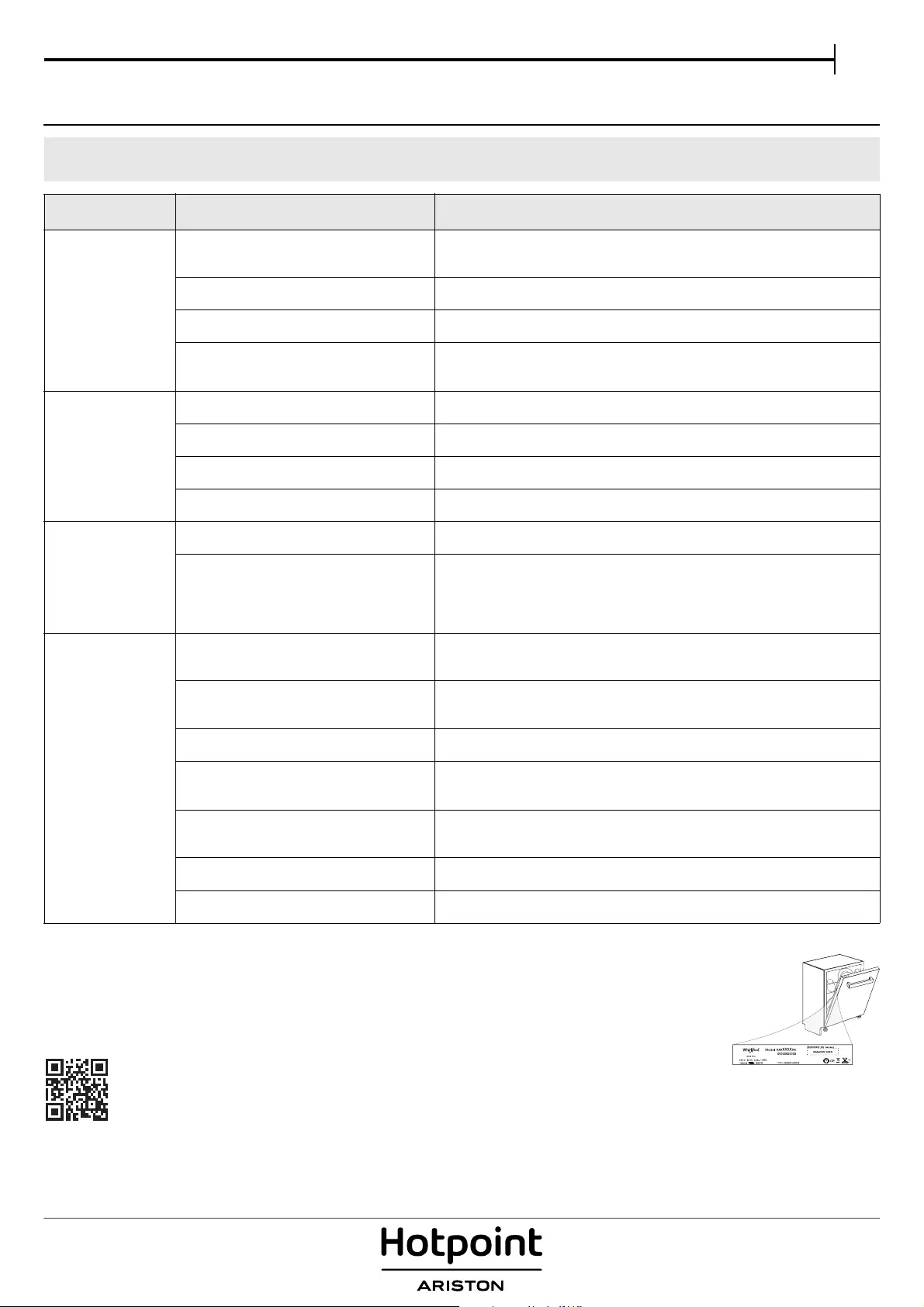
7
EN
TROUBLESHOOTING
Your dishwasher may not work properly.
Before contacting the Service Centre check if the problem can be solved by going through the following list.
PROBLEMS POSSIBLE CAUSES SOLUTIONS
The dishwasher
won’t start or does
not respond to com-
mands.
The appliance has not been plugged in
properly.
Insert the plug into the socket.
Power outage. The dishwasher starts automatically when the power returns.
The dishwasher door is not closed. Vigorously push the door until you hear the “click”.
It does not respond to commands. Switch off the appliance by pressing the ON/OFF button, switch it back on
after approximately one minute and reset the program.
The dishwasher
won’t drain.
The wash cycle has not finished yet. Wait until the wash cycle finishes.
The drain hose is bent. Check that the drain hose is not bent (see INSTALATION INSTRUCTION).
The sink drain pipe is blocked. Clean the sink drain pipe.
The filter is clogged up with food residues Clean the filter (see CLEANING THE FILTER ASSEMBLY).
The dishwasher
makes excessive
noise.
The dishes are rattling against each. Arrange the crockery correctly (see LOADING THE RACKS).
An excessive amount of foam has been
produced.
The detergent has not been measured out correctly or it is not suitable for
use in dishwashers (see FILLING THE DETERGENT DISPENSER). Reset dish-
washer by pressing the DRAIN button (see OPTIONS AND FUNCTIONS) and
run new program without detergent.
The dishes are not
clean.
The crockery has not been arranged prop—
erly.
Arrange the crockery correctly (see LOADING THE RACKS).
The spray arms cannot rotate freely, being
hindered by the dishes.
Arrange the crockery correctly (see LOADING THE RACKS).
The wash cycle is too gentle. Select an appropriate wash cycle (see PROGRAMS TABLE).
An excessive amount of foam has been
produced.
The detergent has not been measured out correctly or it is not suitable for
use in dishwashers (see FILLING THE DETERGENT DISPENSER).
The cap on the rinse aid compartment has
not been shut correctly.
Make sure the cap of the rinse aid dispenser is closed.
The filter is soiled or clogged. Clean the filter assembly (see CARE AND MAINTENANCE).
There is no salt. Fill the salt reservoir (see FILLING THE SALT RESERVOIR).
MAINTENANCE AND TROUBLESHOOTING GUIDE
For more information, maintenance procedures and troubleshooting,
see the Use and Care Guide.
The Use and Care Guide can be obtained by:
• After-Sales Service; phone number see in warranty booklet.
• download from website: docs.hotpoint.eu
• use QR code:
TECHNICAL DATASHEET
The technical data containing the energy consumption data can be
downloaded from the website: docs.hotpoint.eu
CONTACTING AFTER-SALES SERVICE
When you contact the After-Sales Service,
you must provide the codes shown on
the rating plate attached to the left or
right side inside the door of the
dishwasher. The phone number is listed
in the warranty booklet or on the website:
www.hotpoint.eu

8
400011299570
08/2018 as — Xerox Fabriano
